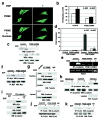Nuclear PKM2 regulates β-catenin transactivation upon EGFR activation
- PMID: 22056988
- PMCID: PMC3235705
- DOI: 10.1038/nature10598
Nuclear PKM2 regulates β-catenin transactivation upon EGFR activation
Erratum in
-
Corrigendum: Nuclear PKM2 regulates β-catenin transactivation upon EGFR activation.Nature. 2017 Sep 20;550(7674):142. doi: 10.1038/nature24008. Nature. 2017. PMID: 28953868
Abstract
The embryonic pyruvate kinase M2 (PKM2) isoform is highly expressed in human cancer. In contrast to the established role of PKM2 in aerobic glycolysis or the Warburg effect, its non-metabolic functions remain elusive. Here we demonstrate, in human cancer cells, that epidermal growth factor receptor (EGFR) activation induces translocation of PKM2, but not PKM1, into the nucleus, where K433 of PKM2 binds to c-Src-phosphorylated Y333 of β-catenin. This interaction is required for both proteins to be recruited to the CCND1 promoter, leading to HDAC3 removal from the promoter, histone H3 acetylation and cyclin D1 expression. PKM2-dependent β-catenin transactivation is instrumental in EGFR-promoted tumour cell proliferation and brain tumour development. In addition, positive correlations have been identified between c-Src activity, β-catenin Y333 phosphorylation and PKM2 nuclear accumulation in human glioblastoma specimens. Furthermore, levels of β-catenin phosphorylation and nuclear PKM2 have been correlated with grades of glioma malignancy and prognosis. These findings reveal that EGF induces β-catenin transactivation via a mechanism distinct from that induced by Wnt/Wingless and highlight the essential non-metabolic functions of PKM2 in EGFR-promoted β-catenin transactivation, cell proliferation and tumorigenesis.
Figures




Comment in
-
PKM2: a new player in the β-catenin game.Future Oncol. 2012 Apr;8(4):395-8. doi: 10.2217/fon.12.11. Future Oncol. 2012. PMID: 22515442
References
-
- Cairns RA, Harris IS, Mak TW. Regulation of cancer cell metabolism. Nat Rev Cancer. 2011;11:85–95. - PubMed
-
- Koppenol WH, Bounds PL, Dang CV. Otto Warburg’s contributions to current concepts of cancer metabolism. Nat Rev Cancer. 2011;11:325–337. - PubMed
-
- Lu Z, Hunter T. Wnt-independent beta-catenin transactivation in tumor development. Cell Cycle. 2004;3:571–573. - PubMed
Publication types
MeSH terms
Substances
Grants and funding
LinkOut - more resources
Full Text Sources
Other Literature Sources
Molecular Biology Databases
Research Materials
Miscellaneous

